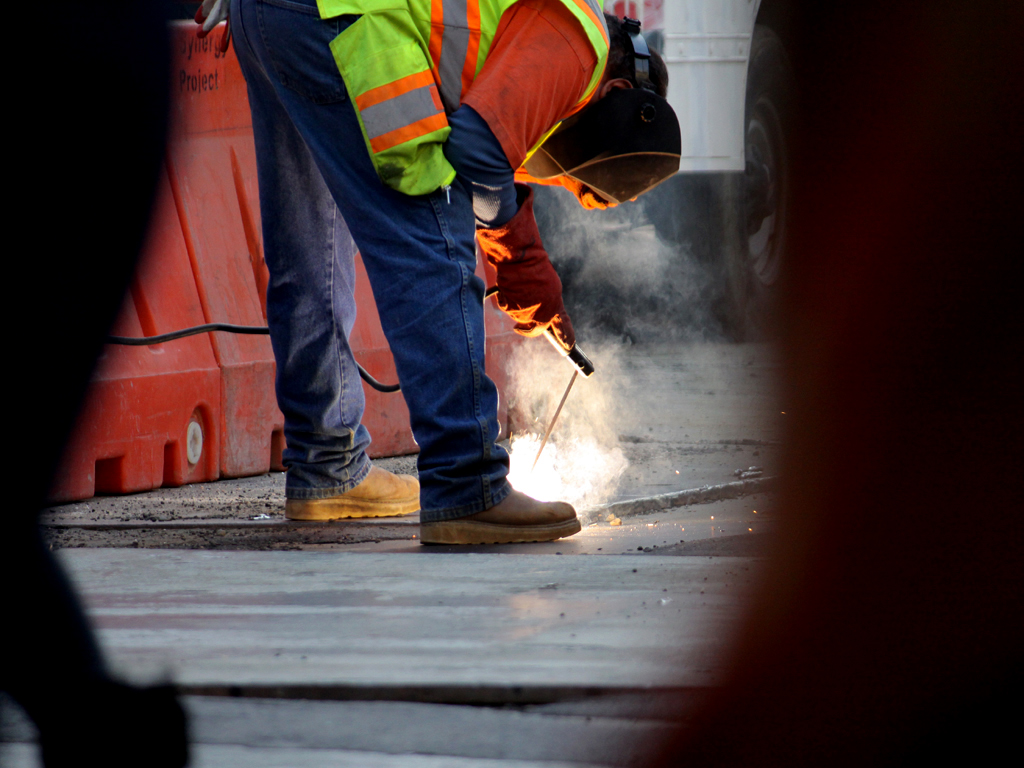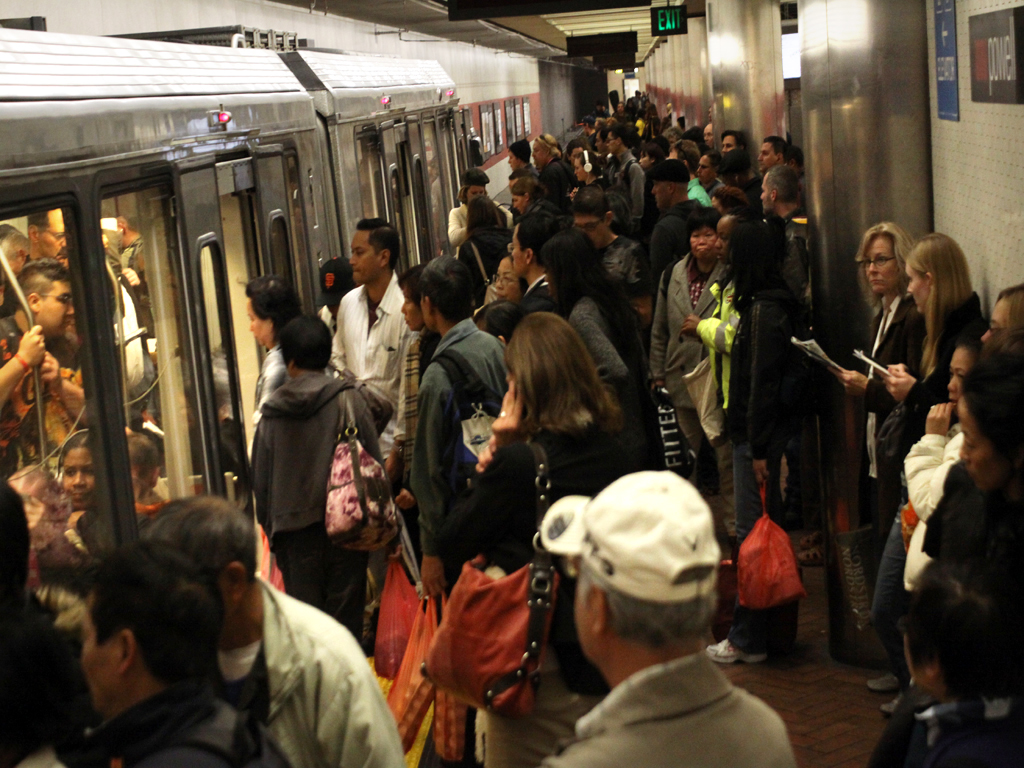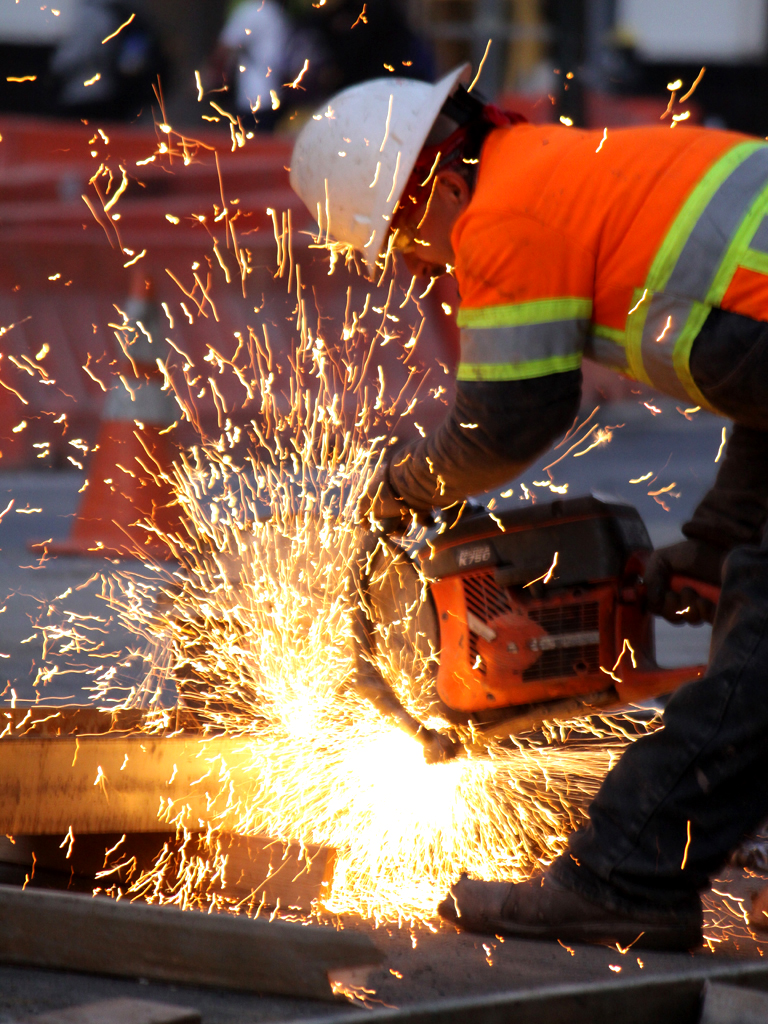By Chris Torres
Photos by Hang Chen
It’s twenty after eleven on Tuesday morning in Chinatown. People browse storefronts, trudge up the hill, hang laundry out to dry from lines strung from a neighbor’s side window. Folks exchanging information, glances, loose change. A pair of tourists from somewhere in Europe armed with a map and cameras pass into a hole-in-the-wall shop selling produce and postcards. A man hoses down the sidewalk. San Francisco’s most densely populated neighborhood woke up hours ago.
It’s standing room only on the 30-Stockton bus between Broadway and Market. People have places to be—it’s Tuesday. Market Street is going to be packed. BART is running on time. More are boarding from all doors, and it looks like this bus is going to miss the next outbound Caltrain by three minutes. “Please hold on.”
San Francisco has a plan to completely overhaul this crowded line. With a cost hovering around $1.6 million, and a time commitment of roughly a decade from the plan’s inception, the city can’t afford to back out now. Ground on the project was broken last year, and the Central Subway is expected to be operational in 2019. With 48 percent of the total funding coming from federal sources, 23 percent from the state and 29 percent from local sources, the project isn’t so daunting, at least according to the SFMTA.

The completed second phase of the T-Third Street line, an underground subway running north along Fourth Street from King Street and the existing light-rail line along Third, will travel underneath the Market Street Subway, then continue further north under Stockton Street, and turn around under North Beach.
The new alignment is “expected to dramatically increase ride time from the beginning of the Third Street alignment to the northern terminus at Chinatown,” according to a Board of Supervisors Resolution. The Board estimates ride time between Broadway and Market Street to be improved from 20 minutes to about 7.
There have been alternative plans tossed around, such as whether to run the subway under Fourth Street, or rather continue the line under Third to later link up with Stockton Street.
The SFMTA predicts that by 2030, the T-Third Street, including the Central Subway addition, will have a “20 percent higher ridership level than the N-Judah,” which is currently Muni’s busiest line. Additionally, the MTA predicts an estimated 30,000 jobs will be created by the project.

While the project’s ‘why’ might not be in question, its ‘how’ might be. SF State professor Jason Henderson, an expert in the geography of transit, is neither for nor against the plan. But he sees the terminus at Broadway as a major flaw. “The problem with the Central Subway is that it doesn’t come out the other side… the original versions had it actually coming out on to Geary, and then run[ning] to the west side.” During BART’s construction, there was talk of running a line down Geary, then north over the Golden Gate Bridge into Marin County.
Somewhere during planning, it was settled that the Central Subway would turn around underneath North Beach, just past the proposed Chinatown Station. While the line could, in theory, be further extended in the future, the $1.6 billion price tag is something that Professor Henderson finds difficult to reconcile. It would make more sense, he says, to spend that money to augment the existing system to be more in line with San Francisco’s “Transit First” initiatives.
The Van Ness Corridor is currently undergoing tests to determine if a strictly transit lane could improve Muni’s flow along the often busy stretch of Highway 101. Another option would be to add more limited, or express, bus lines to reduce the number of stops on the highest volume lines.

“There’s two problems in San Francisco that make Muni unreliable,” Professor Henderson believes. “Number one, the cars. The buses get stuck behind the cars… the other thing is that they [passengers] board at the front door. There really should be all-door boarding.”
The Neighborhoods
Driving a subway line through existing infrastructure is no small task. “The project will require the demolition of rent controlled housing stock and displacement of 19 low-income households from Chinatown,” according to an MTA impact study.
The report further predicts that the Stockton and Third Street Corridors are expected to “see a 26 percent increase in population and a 61 percent increase in employment,” as a result of the Central Subway. Planners are hoping the line’s proximity to Caltrain and BART will allow for easier commuter access from across the Bay Area and down the peninsula.
The Stockton Street Corridor is among the busiest thoroughfares in San Francisco. Terry Joan Baum, a playwright and activist who ran for mayor in the 2011 election, told XPress in a September, 2011 interview that she’s completely behind “solving transit needs right now with really extensive rapid transit bus [service], with infrequent stops.”
Mulling over the logic of driving a subway tunnel under existing downtown urban infrastructure, noting that it’s “absurd on the face of it to have this gigantic project because a few blocks of Stockton Street move very slowly.” She suggests to simply fix those few blocks of Stockton Street with simple changes, such as eliminating street parking along some stretches, or making the most crowded segments bus only.

The Third Street stretch of the line has grown in the years since construction. Around 54 percent of Third Street Corridor residents do not own a car. While long stretches of Third Street are non-residential, much of Potrero Hill, Bayview/Hunters Point, and the surrounding areas are. In addition to the line’s proximity to Caltrain and BART, the T-Third Street also serves both AT&T Park and Candlestick, as well as the growing UC San Francisco developments in Mission Bay.
If the growth in South Market and along the Third Street Corridor is some indication of a neighborhood’s evolution with the addition of rapid transit, then the MTA’s prediction of increased population andemployment could be an accurate glimpse of the future.
Subway Stations
In order for the Central Subway to come into working order, some existing structures will have to be demolished to create stations. The Board of Supervisors has already set plans to provide assistance to those displaced by the project’s construction. While there is no true way to immediately predict how, or if, the transit improvement might give rise to growth and development in the surrounding neighborhoods, the city does know that it will need to provide these relocation packages to build Chinatown Station and Moscone Station. The Board of Supervisors are including provisions in the package that would allow tenants of these properties not only to remain in San Francisco, but also in or reasonably near their current location.
The first of two critical properties, a gas and smog station at 4th and Folsom in South Market, is operated by Convenience Retailers LLC, and is the planned site of Moscone Station. The adjoining smog shop is independently owned and operated.

The MTA report notes that service stations are strategically placed to best serve drivers through a region’s busiest thoroughfares. It further recognizes that such stations can’t be relocated too closely to opposing corporate entities if it would negatively impacting their business. Convenience Retailers LLC has already relocated.
The second property, located at Stockton and Washington, is a privately owned, rent controlled, multi-unit building, and the planned site of Chinatown Station. The building houses eight retail tenants, ranging from restaurants and hair salons to a butcher shop and office space. Upstairs, there are 19 families living in 18 residential units, amounting to about 56 total people. Tenants can negotiate their own relocation package, including the property owner for the building itself.
The report recognizes the area’s historical significance, as well as the tourist draw. Much as the Tenderloin and Chinatown was reconstructed after the 1906 quake and conflagration to support a large bachelor workforce. At present, many of these units are housing entire families and, according to the MTA’s impact report, are showing “significant signs of deferred maintenance.”
San Francisco is set to take on some distinctive changes over the next ten years. In addition to the Central Subway, the waterfront will see some new cosmetic renovation for the America’s Cup in 2014. The new Transbay Terminal, which should be in service by 2019, includes plans for thirteen new towers around the new terminal. If all goes according to plan, the city’s skyline could be dramatically different by 2021.
A subway line is only one small piece of this.


Denise D'Anne • Feb 20, 2012 at 9:42 pm
Chinatown will never be the same as speculators will hone in to take advantage of the Central Subway infracstructure. Watch for high risers destroying the very character of this unique part of our city